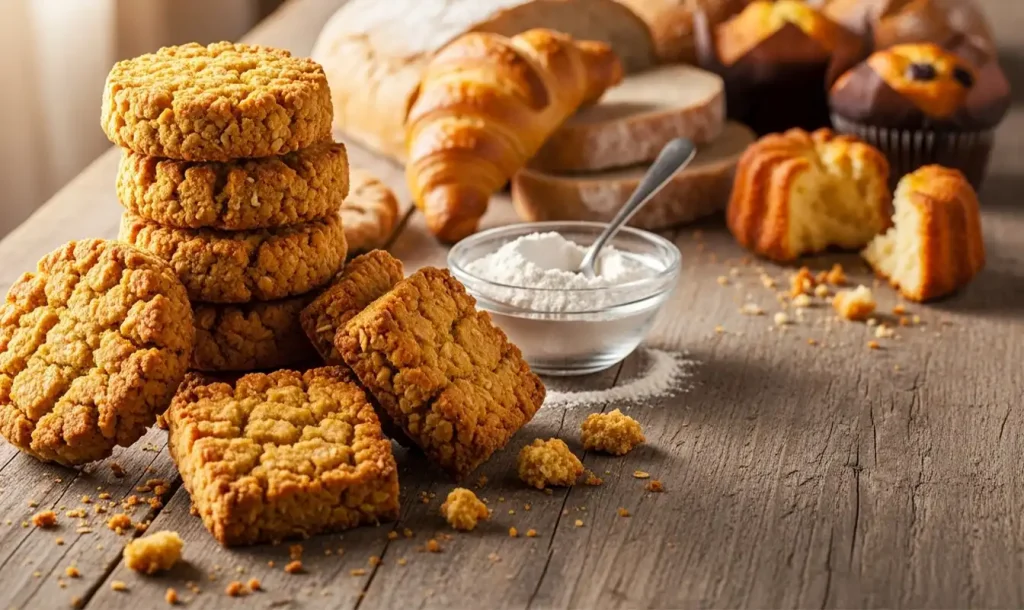So, you’re asking, are Anzac biscuits gluten free? It’s a vital question for anyone who wants to enjoy a piece of history without compromising their health. No, it’s not! Let’s dive deeper.

Traditional Anzac biscuits are not gluten-free. Their historic, core ingredients are standard wheat flour and rolled oats, which are almost always cross-contaminated with gluten.
But the story doesn’t end there. The reason why those ingredients were chosen is the very reason the Anzac biscuit became a national icon. To understand this legend, we have to go back to the kitchens of World War I, where a lack of eggs and the desperate need for a long shelf-life created a recipe for the ages.
A Taste of Home: The Genius Behind the Original Anzac Biscuit
During WWI, women across Australia and New Zealand were desperate to send a taste of home to their sons, husbands, and brothers fighting overseas as part of the Australian and New Zealand Army Corps (ANZAC). They faced a monumental challenge: how do you bake something that can survive a two-month sea voyage without spoiling?
Eggs, the usual binding agent, were out of the question. They would spoil long before a care package ever reached the shores of Gallipoli.
So, the women on the home front turned to their pantry staples: flour, sugar, and rolled oats. But the real genius came from what they left out and what they poured in. The recipe had no eggs. Instead, it relied on golden syrup.
Golden syrup was the miracle ingredient, acting as both a powerful binder and a preservative. This allowed them to create a delicious, high-energy biscuit that was sturdy enough for the months-long journey. These ingredients weren’t chosen for taste alone; they were a brilliant feat of wartime food science, born from love and ingenuity.
The Great Gallipoli Myth: The Biscuit in the Trenches vs. The Biscuit from Home
One of the most persistent myths is that soldiers were eating these sweet, oaty biscuits in the trenches at Gallipoli. It’s a romantic image, but it’s wrong. The reality on the front line was far grimmer.
Truth vs. Legend: The “Anzac Wafer”
Let’s be clear. The main “biscuit” issued to soldiers as part of their rations was a notoriously inedible object officially called a “ship’s biscuit.” The soldiers called it the “Anzac wafer” or simply “hardtack.”
This was a rock-hard, flour-and-water tile—more like a building material than a treat. These biscuits were so hard they were famous for breaking teeth. Soldiers had to grind them into dust to thicken stew or soak them in tea for ages just to make them chewable.
The Real “Soldiers’ Biscuit” from Home
The Anzac biscuit we know and love was a completely different thing. It was never a standard-issue military ration. It was a precious gift that arrived in care packages from home.
The contrast could not be more stark. The hardtack was a tool of survival, issued by the army. The sweet Anzac biscuit was a message of love, baked by mothers and wives. It was a moment of comfort, a tangible connection to family thousands of miles away.
From “Rolled Oat Biscuit” to National Icon: How Anzac Biscuits Got Their Name
The Anzac biscuit didn’t just appear out of thin air. Its history is a fascinating journey, from its humble ancestors to the icon we cherish today.
The Pre-War Ancestors: Scottish Oatcakes
The idea wasn’t new. Its roots trace back to the simple, durable [Scottish oatcakes], known for their long shelf-life and nutritional value. They were the logical blueprint for a wartime recipe.
The First Published Recipes (1917-1921)
The first recorded recipes for this type of biscuit appeared around 1917, notably in publications like the War Chest Cookery Book. But they weren’t called “Anzac Biscuits” yet. They went by names like “Rolled Oat Biscuits” or “Soldiers’ Biscuits.” The name “Anzac Biscuit” was only widely adopted after the war ended, as a formal tribute to the soldiers of the Australian and New Zealand Army Corps.
The Great Coconut Debate: A Modern Addition?
One of the hottest debates is about desiccated coconut. So, was it in the original?
According to culinary historians like Allison Reynolds, the evidence is clear: coconut was not a feature of the earliest wartime recipes. It was a popular addition that became standard in the decades following the war, especially in Australia, where it’s now considered essential.
Can You Make Gluten-Free Anzac Biscuits? (Yes, Here’s How)
While the traditional biscuit is off-limits for a gluten-free diet, the answer is a resounding yes—you can absolutely make a [delicious gluten-free version]. You just have to be precise with your ingredient swaps.
This is not a recipe, but your expert guide to the necessary modifications:
- Flour: This is a simple swap. Replace the standard wheat flour with a quality, [measure-for-measure gluten-free all-purpose flour blend].
- Oats: This is the most crucial swap. You must use [certified gluten-free rolled oats]. Standard oats are processed on the same equipment as wheat and barley, leading to cross-contamination that is dangerous for anyone with celiac disease. Always check the package for the “certified gluten-free” label.
The great news is the other core ingredients—golden syrup, sugar, butter, and baking soda—are all naturally gluten-free. This makes the conversion simple once you’ve secured the correct flour and oats.
A Legacy Protected by Law: The Meaning of the Name “Anzac”
Here’s a fact that separates casual fans from true experts: the term “Anzac” is legally protected. Its use is not a casual affair. It is an act of national remembrance governed by law.
In Australia, the Department of Veterans’ Affairs controls its use. In New Zealand, it’s the Ministry for Culture and Heritage. You cannot simply use the name “Anzac” on a commercial product without permission.
Crucially, the recipe itself is protected. To be legally called an “Anzac Biscuit,” it must remain true to its origins. You can’t add chocolate chips or eggs and sell it as an Anzac biscuit. This legal protection ensures the biscuit remains a respectful tribute, especially around Anzac Day, not just another commercial cookie.
Conclusion: A Biscuit That Binds a Nation
We began with a simple dietary question—are Anzac biscuits gluten-free—and found a story etched into the heart of two nations. The traditional biscuit isn’t gluten-free because its very identity—its sturdiness, its longevity, its history—was forged from the practical needs of World War I and the enduring power of love.
It is more than a recipe. It’s a symbol of remembrance, a lesson in ingenuity, and a delicious link to the resilient Anzac spirit we celebrate each Anzac Day.
Your Anzac Biscuit Questions Answered (FAQ)
Q1: Are traditional Anzac biscuits gluten-free? No. Traditional Anzac biscuits contain wheat flour and non-certified oats, so they are not gluten-free.
Q2: What is the main difference between an Anzac biscuit and a regular oatmeal cookie? The key difference is the lack of eggs. Anzac biscuits use golden syrup as the binder, which creates their unique chewy-crisp texture and gives them a very long shelf-life.
Q3: Is the Anzac biscuit from Australia or New Zealand? It’s a cherished, shared history. Recipes for the biscuit appeared in both countries around the same time during WWI. It remains a powerful national symbol for both Australia and New Zealand.
Q4: Why can’t you call them “Anzac cookies”? In Australia and New Zealand, “biscuit” is the historically correct and respectful term. Due to the legal protections around the name “Anzac,” calling it a “cookie” is seen as an Americanization that strays from its origins and traditions.
